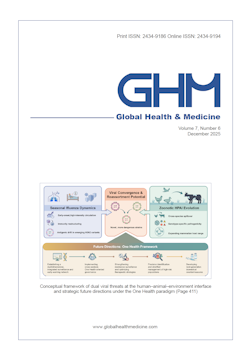Global Health & Medicine 2021;3(4):203-213.
Promoting analysis of real-world data: Prospects for preventive cardiology in Japan
YotsumotoH, Kaneko H, Itoh H, Kamon T, Kiriyama H, Fujiu K, Takeda N, Morita H, Komuro I
According to the statistics for 2018 in Japan, cardiovascular disease and cerebrovascular disease were the most common causes of death (cardiovascular disease with 208,210, cerebrovascular disease with 108,165), and these two diseases account for 23.2% of all deaths. Stroke, especially cerebral hemorrhage, was the main cause of death in Japan after World War II. Along with improved management of hypertension, the mortality rate from cerebral hemorrhage reached a high of 266.7 per 100,000 men in 1960 and 213.9 per 100,000 women in 1951, then decreased to 15.9 per 100,000 men and 6.9 per 100,000 women in 2013. However, mortality from lifestylerelated diseases such as metabolic syndrome and ischemic heart disease has been on the rise since 1990 due to the westernization of diet, urban lifestyles, and lack of exercise habits. Moreover, since aging is the greatest risk factor for heart failure, the number of patients with heart failure in Japan will inevitably increase in the future. A large amount of evidence has demonstrated that prevention and proper management of risk factors can reduce the future incidence of cardiovascular disease. Specific health checkups (metabolic syndrome checkups) have been carried out in Japan since 2008. Big data on physical examinations are valuable real-world data that can be utilized for clinical research. As the importance of preventive cardiology increases in the future, we should analyze the real-world data from health checkups in Japan in detail and disseminate these results to clinical practice, which will contribute to development of preventive cardiology and the promotion of public health.
DOI: 10.35772/ghm.2020.01077







